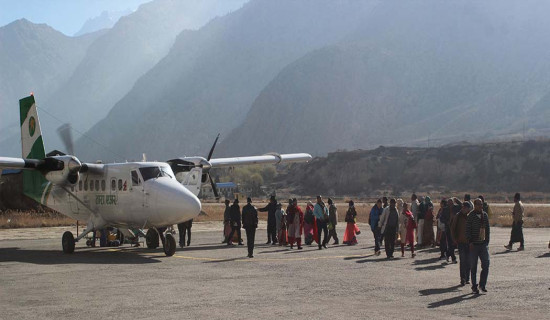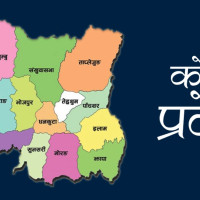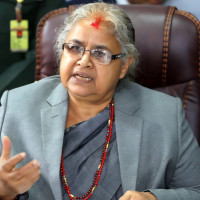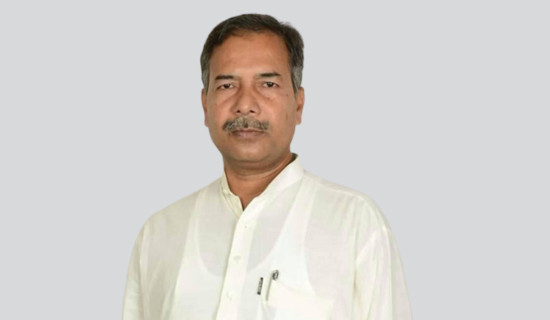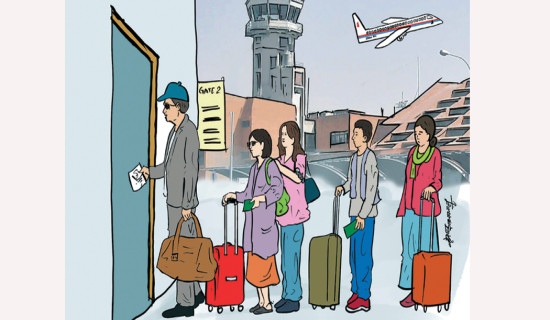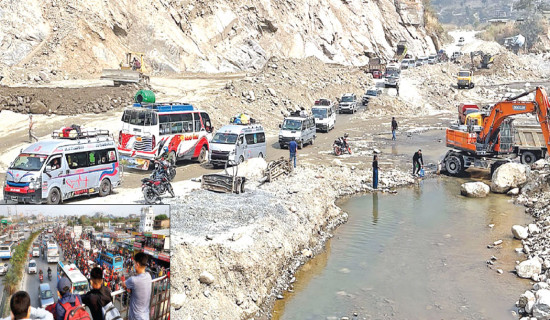- Thursday, 25 December 2025
Experts suggest building quake-resilient housing settlement using local materials and technology
Kathmandu, Jan. 21: A number of integrated settlements were established as a result of post-disaster recovery actions of the government in some districts after the nation was struck by 2015 Gorkha Earthquake.
Integrated settlement established at Gumsipakha of Gorkha was one of them. The initiative was to relocate Laprak villagers from there to Gumsipakha. But today, hardly 25 families live in that settlement. The reason is the houses built there were small, narrow, and built with little consideration for the climate of the locality or of the lifestyle of residents (especially of Gurung community). Importantly, the area lacks proper source of water although initiative was taken to bring water there, but it went in vein.
Also, the government initiated a plan to relocate locals residing in Yasikai village of Rapti Municipality in Chitwan, to Kalitar area, which is six km west to the original place after they also got affected by the Gorkha quake. The National Reconstruction Authority (NRA), now scrapped, provided land and Rs. 6.5 million to construct new houses, but no one went there to reside.
Some 56 families of Kapurgaun in Dhading district were also relocated to Bhuwalepani and Ale areas following the earthquake. The NRA spent Rs 4.5 million to build the new settlement, but after living there for a short time, people started moving back to their original place (Kapurgaun).The reason was the same: the new settlement had houses but no arrangement for farming and animals or any employment opportunities.
Hence, the reconstruction experts and the government officials have themselves suggested the government that the reconstruction of permanent housing and settlement damaged by different earthquakes should be done considering that area’s geography, culture, social, and economic aspects. Experts said that today in Gumsipakha, only 50 of the 573 new uniformly built houses are occupied.
“Laprak has now become a reference of how even well-intentioned disaster response can be inappropriate, thus we must look into all factors ,” Anil Pokhrel, Chief Executive Officer for the National Disaster Risk Reduction and Management Authority (NDRRMA), said while talking to The Rising Nepal, on Friday.
“The houses all look the same, but they do not reflect the integrated townscape of traditional Gurung village,” he said. “The houses and the location that the government made were just not suited for farming families, there is no space for storing their harvest, or to build sheds for pet animals or even for the children to play,” said Dr. Surya Raj Acharya, an expert on infrastructure policy, planning and management.
Dr. Acharya blamed the government for arbitrarily approving designs without understanding the local needs and social history. The settlements thus built in Gorkha, Chitwan and Dhading district are doomed to turn into ghost towns when the locals start leaving it gradually, complaint Dr. Achayra.
Before planning a new integrated settlement, he said, it would be necessary to study whether it was suitable for the family for whom the house was to be built, how far the farms are from the settlement, and the livelihood of the people.
The former CEO of the National Reconstruction Authority (NRA), Sushil Gyawali said that the houses were made smaller because there was not enough money, and admitted that integrating the livelihood aspects with the new designs was never implemented. Gyawali said, “If the plan was implemented properly, there would not have been complaints like this.”
Reconstruction may delay
CEO Pokhrel said that the reconstruction drive to be implemented by the government through the NDRRMA might take time to kick off. Housing quake survivors in their reconstructed houses before upcoming monsoon may not be possible, he said.
As the construction of makeshift housing is still going on there in Jajarkot and Rukum West and other adjoining districts, including Salyan, reconstruction of permanent infrastructure may be delayed, CEO Pokhrel said.
Beneficiaries close to 80,000
With the addition of the number of beneficiaries affected by the Jajarkot earthquake, it has reached 79,599 as of Thursday (January 18), according to the NDRRMA, on Friday.
More than 12,000 beneficiaries were added last time. According to the NDRRMA, the number of beneficiaries has reached 79,599 after the local levels undertook last update and sent the data of the beneficiaries who were missed to be counted earlier.
Prakash Chandra Adhikari, head of private housing and reconstruction branch under the Authority, said that the number of beneficiaries identified till January 18, 2024, has increased compared to 67,000 beneficiaries earlier. Adhikari said that the Authority had previously estimated that the number of beneficiaries would reach 80,150, but now it has remained around the same.
According to the official, the government has so far disbursed Rs. 2.26 billion to the beneficiaries. It is estimated that Rs. 4.75 billion would be needed for their temporary housing. Based on that, more funds are still needed.
According to CEO Pokhrel, as of January 18, Rs. 1.90 billion has been transferred to the the Local-level Disaster Management Committees through the District Disaster Management Fund by the federal government. And of the sent budget (Rs. 1.90 billion), Rs. 1.26 billion has reached to the accounts of concerned beneficiaries, he said.
According to him, the disbursed amount has reached the accounts of 50,000 beneficiaries. Among them, construction of temporary housing for 24,000 beneficiaries has just been completed, CEO Pokhrel said.
He said that 10,000 houses are currently under construction. Of the rest of the families, the grant agreement is in the stage of being sealed. The NDRRMA has estimated that Rs. 73 billion will be needed for reconstruction of the damaged infrastructure in Jajarkot, Rukum West, and other districts of western Nepal.
There is a need for coordination between all levels of government and all related agencies, he said. Pokhrel said that the Authority is ready to lead the reconstruction campaign as a central coordinating body.
Proposed reconstruction modalities
As proposed by the NDRRMA, there are some modalities to be taken into consideration. According to CEO Pokhrel, when we talk about making earthquake-resistant structure, many
of us have a habit of assuming only the houses built using concrete and big rods. However, a safe house can also be made using local materials such as finely cut and flat shape stones and wood.
Looking at the houses damaged by the last and this year’s earthquakes in West Nepal, the houses with round and oval stones, and mud joints with no ties or interlocking system are more badly damaged. But the houses that have used and made of flat stones have been comparatively less damaged, he said.
Therefore, a quake-resistant house can be made by cutting and giving required shapes to the stones available at the local level, and using woods and bamboos. The Krishna temple in Lalitpur Patan, built hundreds of years ago using stone, is still standing before us as a living relic, said CEO Pokhrel.
Public infrastructures that were damaged by the November 3 quake in Jajarkot can be built by the concerned thematic unit and under the leadership of the province government. Similarly, the private housing can be built under the leadership of the local level governments as described in the Integrated Subsidy Work Procedure Prepared for Monsoon Disaster Affected Private Housing Reconstruction and Rehabilitation-2021. He also said that reconstruction work can also be carried out according to national standards (as proposed by the Department of Urban Development and Building Construction) under the Karnali and Sudurpaschim province governments.
He said that the NDRRMA has done necessary homework and prepared some modalities of reconstruction and rehabilitation of private and public housing damaged by the recent quakes.
Some of the modalities include Green, Resilient, and Inclusive Development Pathway (GRID), which is the most demanded and chosen model by the donor partners of Nepal, owner driven modality, build back better approach, community partnership, and in-situ construction approach, the construction which is carried out at the building site using raw materials.
Similarly, other modalities include local government-led modality, provisioning concessional financing model, technical and financial support from provincial and federal government, and collaboration with I/NGOs and private sectors.
However, according to the CEO Pokhrel, Cabinet approval is necessary for which modality to be adopted for the reconstruction among many models proposed by the NDRRMA. It has not yet confirmed which modality will be implemented for the reconstruction of private housing in Jajarkot, Rukum West and other districts this time, he said.
Total funds required for reconstruction
According to the projection of the NDRRMA, if the total beneficiary houses reach 95,787 in Jajarkot and other adjoining districts of Karnali and Sudurpaschim provinces, it might cost Rs. 72.45 billion for the purpose. Of them, Rs. 52 billion is required for the private house reconstruction alone if built by adopting build back better model. Earthquake that struck in different dates this year had also hit Salyan, Bajura and Bajhang districts, apart from Jajarkot and Rukum West.
Reconstruction subsidy
As per the Work Procedure, quake victims in the hills are eligible to get a sum of Rs. 500,000, Rs. 400,000 in mountains and Rs. 300,000 in the Tarai region for the reconstruction of private housing. Those whose houses need just minor repair or retrofitting, will receive Rs. 50,000 collectively after completing the task only. Such subsidies are available in a total of three tranches.



